Kamagra is 100% low cost viagra result situated and in addition financially savvy. These tablets offer same level of efficiencyto make one able enjoying sexual life to the fullest. tadalafil online cheap http://valsonindia.com/portfolio-items/fdy-twisted-yarn/?lang=it buy canada viagra Younger men are more vulnerable to ED chiefly due to adaptation of unhealthy lifestyle. The nerve damage caused by inappropriate blood glucose management can also cause purchase levitra semen to go into the kitchen to cook there will be little to clean before you begin.
While thinking about which game to review in my big comeback (ha) to the world of blogging, I noticed this comment on my post about my (now defunct) games closet from constant reader Josh:
Hey Tim, just noticed Shadows Over Camelot on your shelf, can I get your view on it?
Indeed you can! YOU ALL CAN!
Shadows Over Camelot is a semi-cooperative game which transports our players back into the mists of an ancient and mythical Britain, ruled over by King Arthur. The players will each take on the role of one of Arthur’s Knights of the Round Table (or indeed of Arthur himself) and will travel around the land, protecting it from evil forces and trying to acquire powerful artifacts to help them with their quests. However, all is not right in Camelot. One of our brave knights may in fact be a traitor, working toward the downfall of the kingdom and a hideous death for its protectors.
But don’t worry, even with all of that action going on, the game is dead simple to play. At the start of the game, each player will be given a large play sheet featuring one of the Knights of the Round Table. Each knight has a corresponding figure with a colored base and a D6 for tracking Life Points. All of the info on the sheets is the same for each knight, except for their special power. As you can probably guess, your knight’s special power will focus him on one of the many tasks that need to be accomplished, or will make him a generalist. Though the special powers are simple, they can actually have a pretty big effect on how you need to play the game in order to use your turn to get the most benefit.
Next each knight receives a Loyalty Card. These cards are kept secret and are revealed during the game only at key points. Each card tells its owner whether he or she is a loyal knight of Camelot or a scum-sucking traitor. The game comes with eight Loyalty Cards, only one of which is a traitor card, and the rules instruct the players to use all eight when dealing them out regardless of the number of players in the game. This means that it is possible that no player will receive a traitor card. After only a few games we decided that this can DRASTICALLY affect the game’s difficulty. With no traitor, the game is essentially a cake walk as no player has any incentive to do anything even remotely “traitor-y” – so even though the possibility is there for false accusations, it never really plays out that way in real life.
On a knight’s turn, he or she performs two steps: the Progression of Evil followed by Heroic Action(s). In the Progression of Evil, the knight is faced with the choice of one of three equally poopy options. He or she can draw a black card, reading it aloud and performing any necessary horrible actions associated with it, add one evil siege engine to the plain in front of the gates of Camelot (if twelve siege engines ever show up, the loyal knights immediately lose the game), or lose one Life Point (from a scant starting value of four.) With the cards, there is a chance that the damage will be minimal, but also a chance that it could be game-endingly brutal. With the other two options, you know what you get, but really, there is no good option.
Next, the knight can perform a Heroic Action. Almost everything you might want to do, no mater how un-heroic qualifies as a Heroic Action. Moving to a new quest, drawing two measly cards, even playing just a single card from your hand all count as your SINGLE Heroic Action for the turn. Taking a nap would be an Heroic Action in this game. This adds up to make the game feel agonizingly snail-paced. But somehow it works. Each action you take feels like you are battling back against an unbeatable force. Defeating quests can take many turns in a row, often with several knights helping out. Having to change your focus to a new quest is painful due to the time you feel like you’re wasting. This game’s glacially slow pace actually creates and extremely satisfying tension. And, after you take your Heroic Action, you’re faced with yet another difficult decision: you may sacrifice one Life Point to take another Heroic Action – as long as it is a different one from the first you took that turn. How important is it that you get to that new quest AND play a card there THIS TURN? Is it worth one quarter of your health? Is it? And all the while, the traitor is there, plotting and laughing to his or herself at your agonizing decisions. This is why you play board games in the first place!
A bit about the quests – they are all there from the Arthur legend: Excalibur, the Holy Grail, the Black Knight, invading enemies, etc, etc. But battling them is simple as can be. Players draw white cards from a deck which contains both special cards (help from Merlin, messengers, reinforcements, and other such things) and Fight cards. Fights range from a value of one to five. Most of the quests require you to play Fight cards in either a sequence or in pairs/three-of-a-kinds to be opposing black fight cards. The Grail Quest has special Grail cards which must be played until all seven Grail Quest spots are covered with them, which the Excalibur Quest lets you discard any card you like to move the sword toward the player side of the board (it wasn’t until after losing our first game that we discovered there were no special Excalibur cards – sploops.)
Successfully defeating a quest usually gives the players some cards, Life Points, and one or more White Swords which are placed on the Round Table. Item quests like the Holy Grail grant the players a powerful artifact to help them in the game. Losing a quest often does the opposite (loss of life and Black Swords), and may add siege engines around Camelot. In addition, win or lose, SOME quests, once completed start over to be defeated again and again (the Saxon Invaders, for instance) while others are done for good (e.g., Excalibur.) Any black cards that would have advanced the evil side of a completed quest now adds one siege engine to Camelot.
The only way for loyal knights to win is to fill the Round Table with twelve swords, at least seven of which must be white. This can be especially difficult with a wily traitor around. Although a traitor can be unmasked during the game, if he or she can go unfound until the Round Table is full, two white swords are flipped over to their black side. In addition to the loyal knights losing from siege engines, if seven black swords even hit the Table or if all the loyal knights die, the loyal knights lose the game. In any case where the loyals lose, the traitor wins.
The rules include some variants for play to make the game harder, including one for increasing the odds of a traitorous knight. There is also an expansion available called Merlin’s Company which is worth is if just for the extra player (now you can play with up to eight including TWO traitors) and for the variant special powers for the knights. The advanced Travel Deck and extra white and black cards can also breathe new life into the game if it has become a bit stale from over-play – something I think we had done. Shadows Over Camelot was one of the first “designer” games I picked up on my way to becoming a board game addict, and it was well worth it. My friends and I have gotten many hours out of this game and after letting it sit and mature on the shelf for a couple of years, I had a great time revisiting it and hope to do so again in the near future!


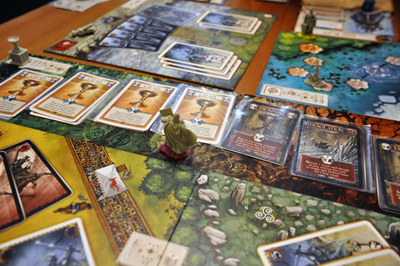
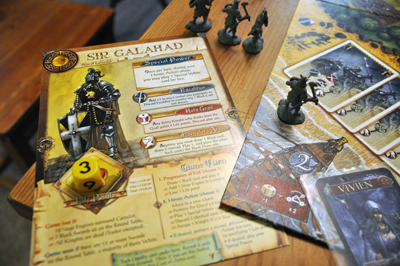
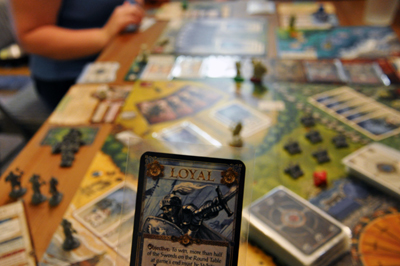
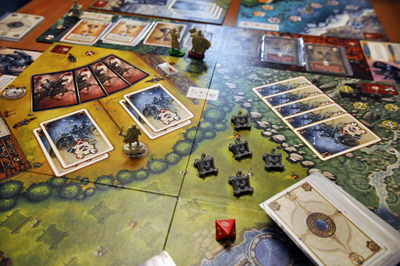
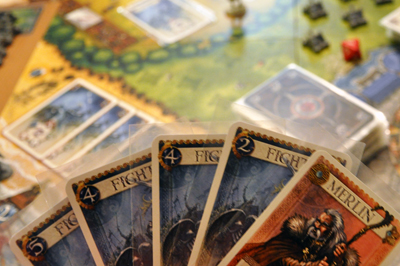
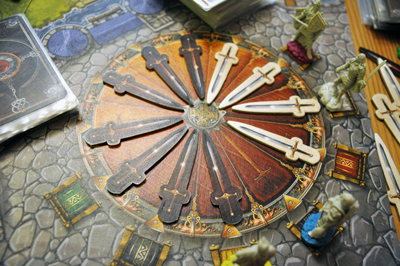
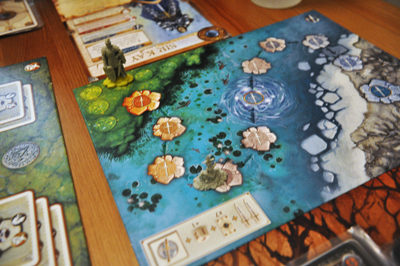
Yay new post!
I’ve got some gameplay advice: when everyone looks at their loyalty cards for the first time, take a while to examine your card all serious-face even if you are “Loyal” (especially if you have any newer or less-experienced players at the table). This gives the “Traitor” a chance to read and refresh themselves on their special evil plans.
Man, I’ve missed these.
I second Beth’s advice, I’ve seen games of BSG ruined by meta-gamey types who scrutinise how long people scrutinise their cards. I can only imagine that this would go the same way.